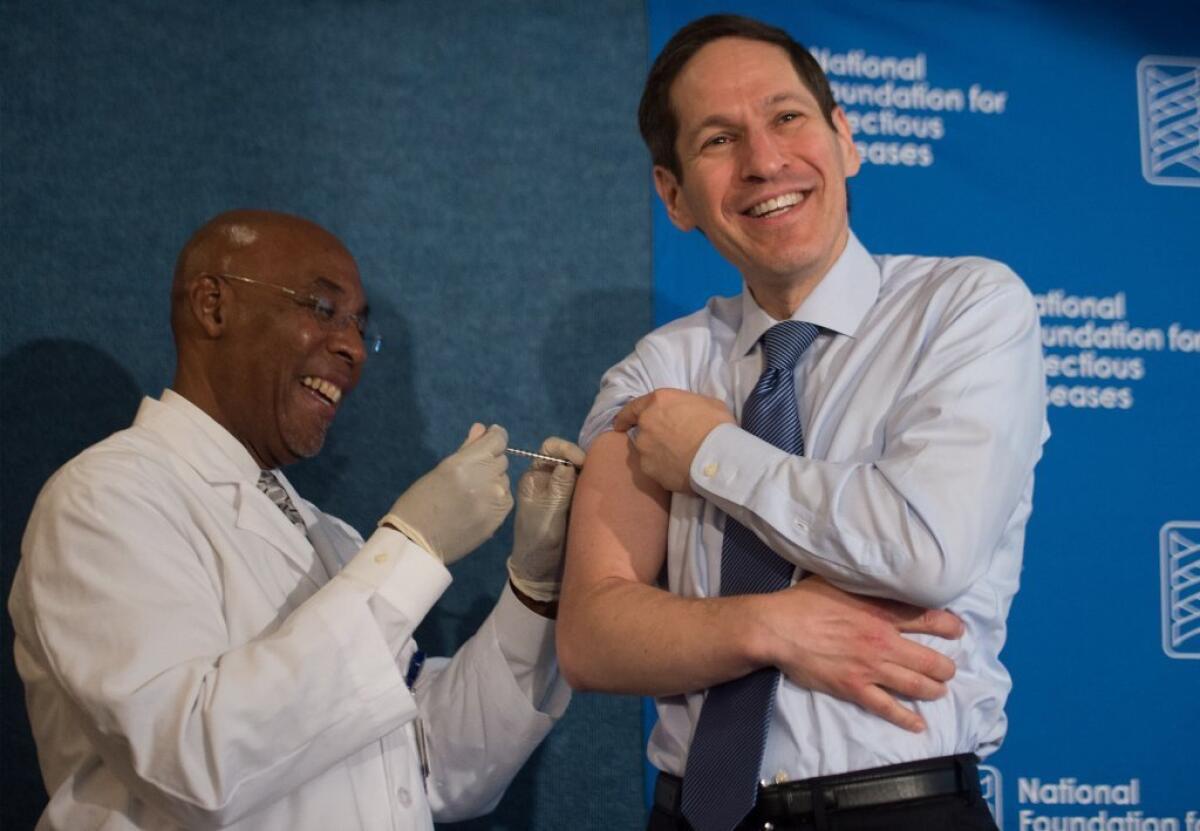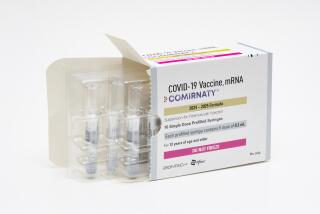This yearâs flu vaccines should work better than they did last year. Hereâs why.

Dr. Tom Frieden, right, director of the Centers for Disease Control and Prevention, demonstrates how easy it is to get a flu shot. This yearâs flu vaccines are a good match to the viruses now in circulation, a new CDC report says.
With the annual flu season approaching, federal officials said Thursday that the flu vaccines available in North America this year are a good match to the influenza viruses that are actually on the loose in the United States.
The new crop of flu shots and flu mists now includes protection against the viral strain known as A/Switzerland/9715293/2013. This H3N2 flu was responsible for the most illnesses during last yearâs flu season, but it emerged too late to be included in vaccines for the United States.
As a result, the overall effectiveness of last yearâs flu vaccines was only 23%, according to the Centers for Disease Control and Prevention. That means that people who got vaccinated were 23% less likely than those who skipped their flu shots to be sickened with a flu-like illness that was bad enough to send them to a doctor.
Flu watchdogs at the CDC have scrutinized 199 flu specimens collected in the United States and elsewhere between May 24 and Sept. 5. The majority of those specimens -- 118 of them -- were H3N2 viruses, and all of them were built in a way that should make them vulnerable to this yearâs vaccines, according to the CDCâs latest Morbidity and Mortality Weekly Report.
Another 20 of the specimens were H1N1 viruses similar to the A/California/7/2009 strain that caused the so-called swine flu pandemic in 2009 and 2010. Last yearâs vaccine targeted that strain, and this yearâs does too.
Of the remaining 61 flu specimens, 35 were similar to the B/Phuket/3073/2013 virus that is included in all North American vaccines. The other 26 were similar to the B/Brisbane/60/2008 virus that is included in the quadrivalent vaccines, which offer protection against four flu strains instead of just three.
NEWSLETTER: Get the dayâs top headlines from Times Editor Davan Maharaj >>
Altogether, the CDC and its collaborating agencies tested more than 80,000 specimens between May 24 and Sept. 5, and only 2.1% of them turned out to be influenza. Confirmed flu viruses were found in 47 states, the District of Columbia and Puerto Rico, the MMWR report said.
As expected for this time of year, complaints of an influenza-like illness were responsible for no more than 1.3% of the total visits to health care providers in any given week. Deaths attributed to flu or pneumonia did not exceed 6.4% of total deaths in any week, which was below the epidemic threshold. One child died of the flu during the reporting period.
The influenza surveillance efforts turned up three cases of flu caused by viral strains that had never before been seen in people. One patient in Minnesota was sickened with a version of an H3N2 virus in July; a patient in Iowa was infected with a novel type of H1N1 virus in August; and a patient in Michigan was sickened by a different H3N2 variant in August.
All three viruses were similar to strains that circulate in pigs, and all three patients had been in direct contact with pigs in the week before they got sick.
The three patients had to be hospitalized, but all of them made a full recovery. There was no evidence that these new viruses were able to spread directly from person to person, according to the report.
CDC researchers also tested 169 flu specimens of various types to see if they had developed any resistance to three antiviral drugs used to fight influenza. All of the specimens were still vulnerable to Tamiflu (oseltamivir), Relenza (zanamivir) and a new intravenous medication called Rapivab (peramivir).
Although thereâs reason to be optimistic that flu vaccines will offer more protection this year, the authors of the CDC report stressed that âit is not possibleâ to predict which flu strains will circulate most widely this fall and winter, nor how well the vaccine will fight against them.
At the same time, they emphasized that âthe best method for preventing influenza and its potentially severe complicationsâ is to get vaccinated, and nearly all Americans who are at least six months old should do so. Vaccine makers expect to have between 171 million and 179 million doses available in the United States this year -- more than any other year except 2009.
In addition to the usual flu shots that are injected into muscle, this year people can choose an intradermal shot that is injected into the skin and thus requires âa much smaller needle,â according to the CDC.
Vaccines also can be administered with jet injectors, which use high pressure to penetrate the skin, or given as nasal sprays. (For the full range of flu vaccine options, check out this CDC fact sheet.)
Follow me on Twitter @LATkarenkaplan and âlikeâ Los Angeles Times Science & Health on Facebook.
ALSO:
Diet heavy on olive oil cuts breast cancer risk by 62%, study says
CDC reveals just how much fast food American kids eat each day
Rx for violence? Crime risk rises for young people on antidepressants, study says







